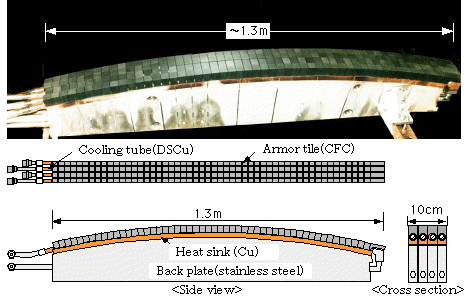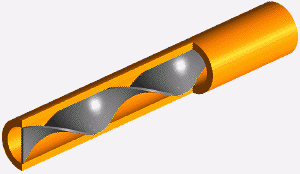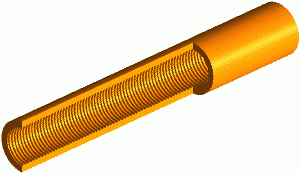In tokamak devices, such as JT-60U and ITER, the vacuum vessels are protected by the first wall and divertor with enormous number of armor tiles. The design of the first wall and the divertor has been taken into account of replacement of the damaged components. In particular, the development of the divertor is one of the critical issues to realize fusion reactors because it is subjected to the highest heat load among the PFCs. The divertor being developed in JAEA has carbon-based armor tiles made of a carbon fiber composite (CFC) material to improve the thermal conductivity and the mechanical strength. This figure shows a full-scale ITER divertor mock-up developed in JAEA. The swirl tube, which has a twisted tape inside to promote turbulent flow of the coolant, is used as a cooling tube. The structural material of the tube is a dispersion-strengthened copper (DSCu). DSCu contains ceramic particle in copper matrix to improve its mechanical strength equivalent to stainless steel. We have successfully developed divertor mock-ups which can meet the ITER divertor requirement. We are presently developing full-scale divertor elements for the ITER divertor prototype.

A full-scale ITER divertor mock-up : This mock-up simulates the ITER divertor vertical target. The rounded shape conforms the magnetic field line. The armor material is made of a carbon fiber composite (CFC) which has high thermal conductivity and high mechanical strength.
High performance cooling tube
Swirl tube : This cooling tube is made of copper and has a twisted tape inside to enhance its heat removal capability by generating spiral flow of the coolant.
Screw tube : This cooling tube has screw threads on the inner wall of the tube to enhance its heat removal capability.
Bonding technology
As shown in the figure of our full-scale divertor mock-up, the ITER divertor consists of CFC armor tiles, copper heat sink blocks and a stainless steel backplate bonded together. In the bonding process of these materials, silver-based brazing*) has been used. However, silver-free brazing materials have recently been developed to minimize harmful waste caused by transmutation of silver due to neutron irradiation. In JAEA, copper-manganese-based or copper-titanium-based braze filler materials have energetically been developed.
*) Brazing : A type of soldering. Braze filler materials which have meting point of 800 - 900 deg-C have mainly been used as bonding materials for the ITER divertor.
- Blanket Technology Group
- What is Divertor?
- Development of basic technologies
- Experiments to develop divertor
- Major test facilities
- Fusion Engineering Research TOP


